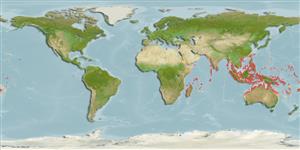Gastropoda |
Littorinimorpha |
Littorinidae
Environment: milieu / climate zone / depth range / distribution range
Ecology
Benthic; brackish; depth range 0 - 22 m (Ref. 100692). Tropical; 26°N - 36°S, 24°E - 167°W
Indo-Pacific.
Length at first maturity / Size / Weight / Age
Maturity: Lm ? range ? - ? cm
Depth range is based on occurrence in Papua New Guinea (Ref. 100692); to be replaced with a better reference. It is found on the upper foliage and trunk (Ref. 112937) of mangroves R. apiculata, R. mucronata, A. alba, A. marina, S. griffithii, S. alba, L. racemosa, C. decandra, C. tagal, B. cylindrical, X. granatum, A. rontundifolia and the palm Nypa fruticans (Ref. 110211).
Life cycle and mating behavior
Maturity | Reproduction | Spawning | Eggs | Fecundity | Larvae
Members of the order Neotaenioglossa are mostly gonochoric and broadcast spawners. Life cycle: Embryos develop into planktonic trocophore larvae and later into juvenile veligers before becoming fully grown adults.
Smith, B.D. 2003 Prosobranch gastropods of Guam. Micronesia 35-36:244-270. (Ref. 3116)
IUCN Red List Status
(Ref. 130435: Version 2025-1)
CITES status (Ref. 108899)
Not Evaluated
Not Evaluated
Threat to humans
Harmless
Human uses
| FishSource |
Tools
More information
Trophic EcologyFood items (preys)
Diet composition
Food consumption
Predators
Population dynamicsGrowth
Max. ages / sizes
Length-weight rel.
Length-length rel.
Length-frequencies
Mass conversion
Abundance
Life cycleReproductionMaturityFecunditySpawningEggsEgg developmentLarvae PhysiologyOxygen consumption
Human RelatedStamps, coins, misc.
Internet sources
Estimates based on models
Preferred temperature
(Ref.
115969): 26.7 - 29.3, mean 28.7 (based on 2431 cells).
